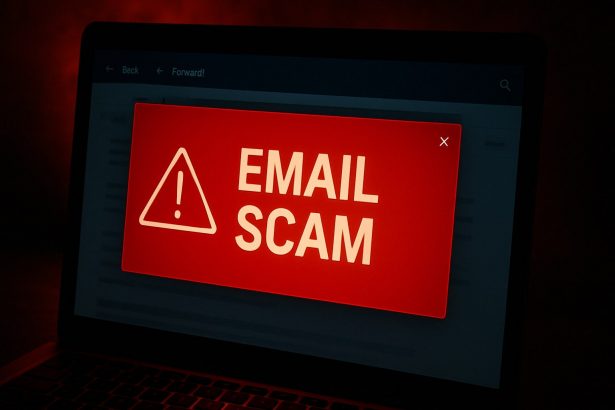Cybercriminals are constantly evolving in their phishing techniques, and one of the more deceptive tactics recently observed is the “From the Crime Fraud Investigation Department Spain” spam email. This email pretends to offer a compensation payout from the Spanish government due to the arrest of alleged fraudsters. In reality, it is a sophisticated phishing scam designed to trick recipients into divulging sensitive personal or financial information — or even sending money under false pretenses.
Let’s break down this threat and show you what to look out for.
The Fake Email Explained
This phishing email impersonates a U.S. detective allegedly working under the Spanish police. The message falsely claims that scammers who had previously defrauded the recipient were arrested and that the Supreme Court of Spain has awarded the recipient €2,000,000 in compensation.
The email instructs recipients to contact a so-called Barrister George Hernández, a supposed legal representative who can facilitate the transfer of the compensation. A contact email address is provided, further drawing the user into the scam.
Here is the full text of the email:
Subject: From the Crime Fraud Investigation Department Spain
This is Roger Louis, United States detective working under Spanish police on Cyber Crime and Internet Fraud.
Be informed that the internet fraudsters who defraud you have been arrested and charged to court, last Friday was the final judgement. The court has ordered the Spanish Government to pay you compensation and damages for all the money you lose to those fraudsters, in which the crime are committed by South Americans and Africans living over here in Spain.
This is to notify you that The Supreme Court of Spain has ordered the Spanish Government to pay you compensation and damages. The sum of €2,000,000.00 (Two Million Euros) has been approved to you in order to compensate you for all the money you lose to those internet fraudsters in Spain.
The Policía Nacional Crime Fraud Investigation Department Spain is very pleased to inform you that your information has been passed to Barrister George Hernández for immediate transfer of your compensation funds from the Spanish Government.
Barrister George Hernández will help you claim your compensation fund from the Spanish Government. You should contact Barrister George Hernández on this email address below.
Contact person: Barrister George Hernández from Principal Attorney George Hernández & Asociados Corporate and Finance Law Firm Madrid, Spain.
Contact email: barrjhgeorge7798@gmail.com
Contact Address: Avda Reina Victoria 58 – Esc. 1, 1єA 28003
If you are interested in receiving the compensation funds €2,000,000.00 – Two Million Euros, you should contact Barrister George Hernández at: barrjhgeorge7798@gmail.com
When contacting the Barrister, please ask for his ID Card, for you to be sure you are in contact with the right person.
Thank you and Congratulation in advance
Best Regards,
Roger Louis
United States detective working under Spanish police on Cyber Crime and Internet Fraud.
Why This Is a Scam
This message is entirely fictitious. There is no detective named Roger Louis operating under Spanish law enforcement, and the Spanish government is not issuing €2 million payouts to scam victims via unsolicited emails. The intent is to:
- Phish for personal or financial data
- Request advance fees under the guise of processing or tax requirements
- Possibly infect your system with malware if attachments or links are included
Threat Summary
| Field | Details |
|---|---|
| Threat Name | “From the Crime Fraud Investigation Department Spain” scam |
| Threat Type | Phishing, Scam, Social Engineering |
| Encrypted File Extension | N/A (not malware-based) |
| Ransom Note File Name | N/A |
| Associated Emails | barrjhgeorge7798@gmail.com |
| Detection Names | Heuristic.Phishing.Email, Phish.Agent.EmailFraud, EmailScam.Generic |
| Symptoms of Infection | Unusual account activity, identity theft, unauthorized financial transactions |
| Damage | Loss of sensitive data, financial loss, identity theft |
| Distribution Methods | Spam emails, spoofed sender addresses, social engineering tactics |
| Danger Level | High (particularly for non-tech-savvy or vulnerable individuals) |
Common Red Flags in the Email
- Generic greetings – no mention of your real name
- Unrealistic promises – €2 million compensation with no strings attached
- Urgency and authority – tries to make it sound like a government-ordered action
- Gmail address – no official agency uses free email services for official compensation
- Grammatical errors – awkward phrasing and spelling mistakes like “Policнa” instead of “Policía”
How to Manually Identify and Remove Email Scams
Manually removing email scams involves recognizing fraudulent messages, securing your accounts, and taking precautions to prevent future attacks. Follow these steps:
Step 1: Identify Suspicious Emails
Before taking action, you need to identify scam emails. Common signs include:
- Unknown Sender: Emails from unfamiliar addresses, especially if they claim to be from banks, tech support, or government agencies.
- Urgency or Threats: Scammers often pressure you to act immediately (e.g., “Your account will be closed in 24 hours!”).
- Poor Grammar & Spelling: Many scam emails contain obvious grammatical mistakes.
- Suspicious Links & Attachments: Hover over links (without clicking) to check the actual URL. If it looks odd, don’t click.
- Requests for Personal Information: Legitimate companies will never ask for passwords, Social Security numbers, or credit card details via email.
Step 2: Do Not Click Links or Download Attachments
If you suspect an email is a scam:
- Do not click on any links.
- Do not open any attachments.
- Do not reply to the sender.
Step 3: Report the Email Scam
You can report the scam email to various authorities:
- Gmail/Outlook/Yahoo Users: Click the “Report Phishing” or “Report Spam” button in your email client.
- FTC (Federal Trade Commission, USA): Report to FTC Complaint Assistant.
- Google Safe Browsing: If the scam email contains a phishing website, report it here.
Step 4: Block the Sender
- Gmail: Open the email, click the three dots in the top-right corner, and select “Block [Sender Name]”.
- Outlook: Open the email, select “Junk” > “Block Sender”.
- Yahoo Mail: Open the email, click “More” > “Block Sender”.
Step 5: Check Your Accounts for Unauthorized Activity
If you accidentally clicked a link or shared sensitive information:
- Change your passwords immediately. Use strong, unique passwords for every account.
- Enable two-factor authentication (2FA). This adds an extra layer of security to your accounts.
- Check your banking statements for unauthorized transactions.
Step 6: Scan Your Device for Malware
Some email scams contain malware hidden in attachments or malicious links. Run a full system scan using built-in tools:
- Windows Defender (Windows 10/11):
- Go to Settings > Update & Security > Windows Security > Virus & Threat Protection.
- Click “Quick Scan” or “Full Scan”.
- Mac Users:
- Use Malwarebytes for Mac or another security tool.
Step 7: Adjust Your Email Security Settings
- Enable email filtering to reduce spam and phishing emails.
- Add a third-party spam filter such as Mailwasher or Spamihilator.
- Educate yourself and others on phishing techniques to avoid future scams.
How to Remove Email Scams Using SpyHunter (Automated Method)
For users who prefer an automated, foolproof method to remove threats linked to email scams, SpyHunter offers an advanced security solution. SpyHunter is an anti-malware tool designed to detect and remove phishing-related threats, spyware, Trojans, and other cyber threats. Follow these steps:
Step 1: Download SpyHunter
- Visit the official SpyHunter download page: Download SpyHunter
- Click on “Download” and save the installation file to your computer.
Step 2: Install SpyHunter
- Locate the downloaded file (SpyHunter-Installer.exe) and double-click to open it.
- Follow the on-screen installation instructions.
- After installation, launch SpyHunter.
Step 3: Perform a Full System Scan
- Open SpyHunter and navigate to “Malware/PC Scan”.
- Click “Start Scan Now” to begin a deep scan of your system.
- SpyHunter will analyze files, registry entries, and processes for any threats linked to email scams, phishing, and malware.
Step 4: Review and Remove Detected Threats
- Once the scan completes, SpyHunter will list all detected threats.
- Click "Fix Threats" to remove them.
- Restart your computer to complete the removal process.
Step 5: Enable Real-Time Protection
SpyHunter includes real-time protection features to help prevent future infections:
- Enable Active Guards: This monitors your system for malware in real time.
- Schedule Automatic Scans: Set up periodic scans to detect new threats early.
Step 6: Keep SpyHunter Updated
- Regularly check for updates to ensure SpyHunter detects the latest threats.
- To update SpyHunter, open the app and go to "Settings" > "Update", then click "Check for Updates".
Preventing Future Email Scams
Now that you've removed email scams, take proactive steps to prevent them in the future:
Use a Secure Email Provider
- Consider switching to a secure email provider like ProtonMail or Tutanota, which offer advanced encryption.
Be Cautious with Email Links
- If you receive an email with a suspicious link, verify the website’s legitimacy before clicking.
Avoid Public Wi-Fi for Sensitive Activities
- Scammers can use public Wi-Fi to intercept your data. Use a VPN when accessing email on public networks.
Regularly Change Your Passwords
- Update your passwords every few months, and never reuse old passwords.
Use Anti-Phishing Extensions
- Install browser extensions like Bitdefender TrafficLight or Avast Online Security to detect phishing links in real-time.
Email scams are a serious cyber threat that can lead to financial loss, identity theft, or malware infections. By following the manual removal steps, you can effectively identify and remove suspicious emails on your own. However, for advanced protection, using SpyHunter ensures a more thorough and automated approach to detecting and removing phishing-related threats.
Recommended Action
For a fast and efficient way to remove email scams and related malware, download and install SpyHunter now: Download SpyHunter
By staying informed and proactive, you can protect yourself from future email scams and online threats!
Conclusion
If you’ve received this email, do not reply or engage with the sender. Mark the message as spam or phishing, delete it, and ensure your system is protected with up-to-date antivirus software.
Let this be a reminder: if it sounds too good to be true — it almost always is.




